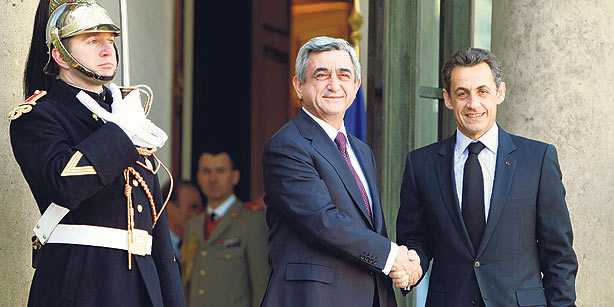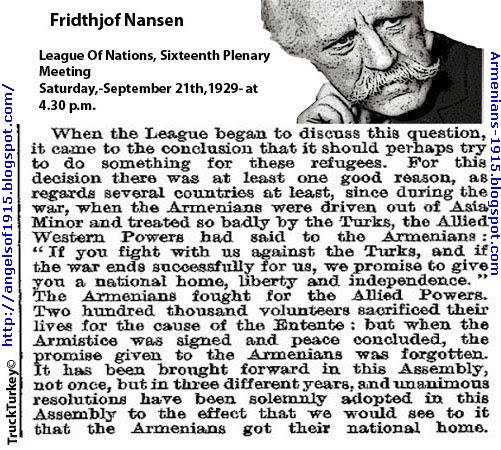
Category: Armenian Question
“The great Turk is governing in peace twenty nations from different religions. Turks have taught to Christians how to be moderate in peace and gentle in victory.”Voltaire’s Philosophical Dictionary
-
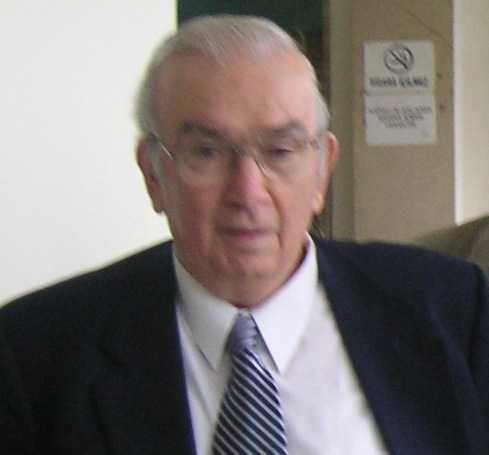
A CRITICAL LETTER FROM ‘SUKRU SERVER AYA’ ON ARMENIAN ISSUE

John Carmichael,MP
Don Valley West Istanbul, April 19, 2012
18 Wyn ford Drive Suite #704
Toronto,ON M3C 3S2Dear Sir,
I have received copy of the message sent by Mr. Ozer Aksoy to you on April 17th, giving his counter comments on your unfortunate message that 1.5 million Armenians were murdered by an act of genocide by Turkz in 1915..
To pinpoint the corner stones of this tale or actual fabrication, I will make myself as brief as possible and submit my “irrefutable written evidences” which are detrimental when discussing history a century later or lecturing history based on unproven rumors, propaganda and hearsays which are marketed by some smart swindlers of diaspora. Please excuse my presentation of documents, instead of a long tirade!
1. If you will kindly click on below link, you can access to some ten pages of information on “google” in English and Turkish, regarding my books, conferences, TV interviews, etc. in U.K., USA and Turkey.
https://www.google.com.tr/#q=Who+is+Sukru+Server+Aya&hl=tr&prmd=imvns&ei=TOGPT7HVC4_ltQbkk4DDBA&start=70&sa=N&bav=on.2,or.r_gc.r_pw.r_qf.,cf.osb&fp=c5822259c7e54a1d&biw=1010&bih=612
2. If you will kindly click below link, you can access to my presentation of my first book “The Genocide of Truth” which can be unloaded freely in PDF format, since 2008. There are over 2000 excerpts all from non-Turkish or denialist sources, such as original official U.S., Armenian, French, British etc. documents.
https://armenians-1915.blogspot.com/2008/04/2429-new-e-book-genocide-of-truth-based.html
3. If you will kindly read my essay standing on the internet since 2008, you can be sure that so far “no person on earth could refute one single word of the excerpts from the three documents” I had summarized therein, namely the “Near East Relief Report” approved unanimously by the U.S. Senate in April 1922, confirming that on 31.12.1921 there were 1.414.000 Armenians alive in the area. We know that the Armenian population within the Ottoman Empire on Match 1, 1914 was less than 1.3 millions.
Hence, someone must explain how it is possible to kill 10.000 persons every single day for 150 days, and bury each lot in stadium size graves opened by hand shovel. Not even Hitler and his death camps could annihilate so many and so far, not even one such mass grave was ever found! There is not a line of Turkish atrocities in that report, bearing the names of the most reputed missionaries, politicians, etc. including two letters of thanks of Armenian patriarchs. Secondly, the book by Garekin Pastermadjian, confesses all the Armenian treason and acts of bravery, and thirdly the memorandum submitted officially to the Paris Peace Conference in February 1919, leaves no blanks for the atrocities of Armenians or the huge land they required “free of non-Christian elements”, which was 80% of the population. I hope that “so much official documents” leave no doubt of the absurdity of any factual genocide.
4. If you really want to learn who killed whom (most), please refer to the following official U.S. document:
https://armenians-1915.blogspot.com/2005/07/67-captain-emory-niles-and-mr-arthur.html
5. Below excerpt should suffice to summarize and attest the story from the most authorized person:

6. Finally Sir, you should be aware by now, that there is not a single court verdict on this subject (which has become compulsory since 2004 under U.N. regulations)! What more the bilateral acts of retaliation “cannot be categorized anything close to the word genocide” in the presence of below document, “a written confirmation of Note Verbale, dated March 1, 1920” by the General Secretary of the League of Nations:
< Page 2: “Further, in Turkey, minorities were often oppressed and massacres carried out by irregular bands who were entirely outside the control of the central Turkish Government.>
7. You may also please refer to the original Newspaper image (Nov.14, 1915) : ending with the following sentence for Americans:
< If this country, therefore, does not want to appear foolish before the whole world it will refuse to be duped by impossible tales and will let the Armenians severely alone.>
CONCLUSION: If you or the Armenian propagandists who served you with unfounded and deliberately distorted accusations can prove a single word of above references be untrue, please write to the blogsite of “truth defending Armenians” ([email protected]) so that you may let the rest of the world what the undistorted TRUTH is or that I am phony researcher!
I am asking Mr. Ozer Aksoy, to send by letter mail a copy of this message, which you may need to refer or show to any person trying to sell the “basket of inversions and lies”, < genocide >.
Yours Cordially,
Sukru Server Aya, Researcher, Istanbul, April 19.2012
Emails: [email protected] & [email protected]
-
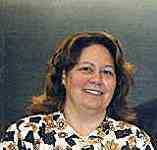
NEWYORK; FATMA MUGE GOCEK AN INSRUMENT OF ARMENIAN PROPOGANDA

WINDOWS INTO TURKEY LECTURE BY FATMA MUGE GOCEK OF UNIVERSITY OF MICHIGAN
CUNY Queens Kolej’de Turk Ogrenci Dernegimize Destek Cagrisi -Ermeni Paneli Onemli
New York Sehir Universitesine bagli Queens Kolejinde Dr Fatma Gocek adli sozde akademisyen Ermeni tezlerini savunan bir programda konusacaktir. Turk Ogrenci Dernegimize destek ve ordaki Ermeni yogunlugunu bastirma amaci ile Turk Amerikan Dernekleri Federasyonu ve bazi Dernek Temsilcilerimiz ile bu programa katilacagiz. Bu bilgiyi, programa katilmak isteyen Dernek Temsilcilerine ve uyelerinede duyurmak istedik.
Queens Koleji Turkiyeyi yilin ulkesi ilan etmesine ragmen boyle bir hata yapmasi kabul edilemez.
Ayrica, TADF olarak Okul Yonetimine kinama mektubu hazirlanmaktadir.
Who : DR. FATMA GOCEK -Ottoman Past, Turkish Present, and the Collective Violence against the Armenians, 1789-2009
Date/Time : Wednesday, April 25, 2012, 7:15 pm
Address: Queens College Center for Ethnic, Racial, and Religious Understanding (C.E.R.R.U). – Rosenthal 230 / 65-30 Kissena Blvd. Flushing, NY 11367
Saygilarimizla,
ALI CINAR
TADF Baskani
Turk Amerikan Dernekleri Federasyonu
821 UN Plaza, 2ci Kat
New York NY 10017
——————————————————- TURKISH FORUMS ADDITION ————–
SOME BACKGROUND INFO FOR ATTERNDEES
Captain Emory Niles and Mr. Arthur Sutherland were Americans ordered by the United States Government (in 1919) to investigate the situation in eastern Anatolia. Their report was to be used as the basis for granting relief aid to the Armenians by the American Committee for Near East Relief. The following is an excerpt from their report.
“…Villages said to have been Armenian were still standing whereas Musulman villages were completely destroyed”
“In the entire region from Bitlis through Van to Bayezit we were informed that the damage and destruction had been done by the Armenians, who, after the Russians retired, remained in occupation of the country and who, when the Turkish army advanced, destroyed everything belonging to the Musulmans. Moreover, the Armenians are accused of having committed murder, rape arson and horrible atrocities of every description upon the Musulman population. At first we were most incredulous of these stories, but we finally came to believe them, since the testimony was absolutely unanimous and was corroborated by material evidence. For instance, the only quarters left at all intact in the cities of Bitlis and Van are the Armenian quarters, as was evidenced by churches and inscriptions on the houses, while the Musulman quarters were completely destroyed. Villages said to have been Armenian were still standing whereas Musulman villages were completely destroyed” [U.S. 867.00/1005].
“…Their evidence was not what those in power wished to hear.”
In “Death and Exile: The Ethnic Cleansing of Ottoman Muslims, 1821-1922,” Professor McCarthy comments, “…Despite their prejudices, they reported evils perpetrated by Armenians.” Since the findings of Niles and Sutherland are so obscure (only one partial copy exists today in the U.S. Archives… “well-hidden among documents on very different topics, luckily not destroyed, but only buried”), one must wonder why it has been so ignored. For example, why have the Harbourd Reports (interpreted by Armenians; Integrity Alert!) misrepresented what Niles had written? Professor McCarthy speculates, “One cannot help but believe that their evidence was not what those in power wished to hear.”
THE REPORT OF NILES AND SUTHERLAND
Niles and Sutherland Chapter from Prof. Justin McCarthy’s “Death and Exile,” pp. 223-228
ADDENDUM, July 2007:
Prof. McCarthy has made the original document available on his university site regarding Turkish history:
https://louisville.edu/a-s/history/turks/Niles_and_Sutherland.pdfFew outsiders saw the situation in eastern Anatolia im- mediately after World War I. Of those who did, one group, American missionaries, were almost completely unreliable as witnesses to Muslim suffering. With the Armenians gone from eastern Anatolia, the life work of the missionaries had been destroyed, and their one-sidedness and understandable bitterness made them unreliable observers. While they were capable of documenting in great detail actions against Armenians, they were with few exceptions incapable of mentioning actions against Muslims. Another group, Westerners, were agents of the British and American governments, suffered from some of the same disabilities as the missionaries, and were also prejudiced. Some of them, however, rose above their prejudices to become accurate observers.
Captain Emory Niles and Mr. Arthur Sutherland were Amer- icans ordered by the United States government to investigate the situation in eastern Anatolia. Their report was to be used as the basis for granting of relief aid by the American Committee for Near East Relief (ACNRE, more usually “Near East Relief). The two men were quite unusual. Like Lt. Dunn, who provided Admiral Bristol with much accurate intelligence, Niles and Sutherland decided simply to ride through the area until they saw what was needed. Also, like Dunn, they did it with a minimum of support and with great courage. Their courage extended to their report, for they set down what they actually saw and heard, not what their prejudices dictated to them. For Americans in Anatolia, this was a rare phenomenon. The remarkable fact is that they were concerned about Muslims, not as Muslims but as human beings who were in need of relief. Perhaps naively, they assumed that their orders covered reporting all those in eastern Anatolia who were in need of relief, not only Christians, and they did so. Most of those in need were Muslims, and the suffering they reported was mainly Muslim suffering. It may be for that reason that their report was never included in the papers of the American Investigation Commissions; only a partial copy of it can be found in the American Archives, well-hidden among documents on very different topics, luckily not destroyed, but only buried.215
In most cases, Niles and Sutherland simply reported what they saw, without comment. However, as they began to observe what was actually happening, they also began to change what had been their typical Western opinions about Turks and Armenians:
[Region from Bitlis through Van to Bayazit] In this entire region we were informed that the damage and destruction had been done by the Armenians, who, after the Russians retired, remained in occupation of the country, and who, when the Turkish army advanced, destroyed everything belonging to the Musulmans. Moreover, the Armenians are accused of having committed murder, rape, arson and horrible atrocities of every description upon the Musulman population. At first we were most incredulous of these stories, but we finally came to believe them, since the testimony was absolutely unanimous and was corroborated by material evidence. For instance, the only quarters left at all intact in the cities of Bitlis and Van are the Armenian quarters, as was evidenced by churches and inscriptions on the houses, while the Musulman quarters were completely destroyed. Villages said to have been Armenian were still standing, whereas Musulman villages were com- pletely destroyed.216
Niles and Sutherland were not pro-Turkish or pro-Muslim observers. On the contrary, they came to eastern Anatolia with all the usual American prejudices in place. Although they had never seen evidence of Muslim massacres of Armenians, they believed them to have taken place and to have been as awful as was commonly believed in the West. They commented, “We believe that it is incontestable that the Armenians were guilty of crimes of the same nature against the Turks as those of which the Turks are guilty against the Armenians.” The difference, of course, is that they had seen the evidence of the Armenian crimes, not the Turkish—the one charge is based on evidence, the other on hearsay. However, this makes it more reliable concerning what they actually saw, because, despite their prejudices, they reported the evils perpetrated by Armenians.
The two Americans reported on the condition of eastern Anatolia after the war. The picture they painted was of a desolate place where crops, houses, and human lives had been destroyed. In the area between Erzurum and Bayazit, they found that the surviving Muslims had no milk, meat, or grain. The Muslims lived on wild grain and wild vegetables, “neither of which has much food value.” The Muslims blamed their fate on the Armenians and the Americans agreed:
In this region [Bayazit-Erzurum] the racial situation is intensely aggravated by the proximity to the frontier of Armenia, from which refugees are coming with stories of massacres, cruelty and atrocities carried on by the Armenian Government, Army and people against the Musulman population. Although several hundred Armenians are actually living in the vilayet of Van, it would seem impossible that Armenians could live in the rural regions of the vilayet of Erzerum, since the utmost hatred of them is manifested by all. Here also the Armenians before retiring ruined villages, carried out massacres, and perpetrated every kind of atrocity upon the Musulman population and the doings of the Armenians just over the frontier keep alive and active the hatred of the Armenians, a hatred that seems to be at least smoldering in the region of Van. That there are disorders and crimes in Armenia is confirmed by refugees from Armenia in all parts of the region and by a British officer at Erzerum.217
In the region between Erzurum and the Armenian frontier, the destruction had been nearly complete. Retreating Armenians had destroyed every possible village on their line of retreat. Two- thirds of the housing had been destroyed, as had most of the Muslim population: “The region218 has between one-third and one-fourth of its former population, varying in certain districts. Those cities and villages on the line of retreat of the Armenian army suffered most.”219 “All the villages and towns through which we passed showed the marks of the war. Most of them were completely ruined.”220
The most eloquent evidence given by Niles and Sutherland was statistical—enumerations of surviving Muslim villages and houses. In considering Van and Bitlis, for example, they found that in 1919 both cities had 10 percent or less of their pre-war population. The Armenians had destroyed all but a few Muslim houses (Table 19). All the public buildings and Muslim religious structures were gone.
TABLE 19.
DESTRUCTION IN THE CITIES OF VAN AND BITLIS.Houses Before Wars Aug 1919 Van Muslim 3,400 3 Armenian 3,100 1,170 Bitlis Muslim 6,500 — Armenian 1,500 1,000SOURCE: Niles and Sutherland.
A similar situation was found in other villages. Most Muslim villages were simply gone, whereas Armenian villages had survived. Niles and Sutherland gave examples from the vilayet of Van and the sancak ofBayazit (Table 20).
TABLE 20.
VILLAGES IN VAN VILAYETI AND BAYAZIT SANCAGI,
BEFORE AND AFTER THE WAR AND ARMENIAN OCCUPATION.VAN BAYAZIT BeforeWar-Aug1919 BeforeWar-Aug1919 Muslim 1,373 350* 448 243 Armenian 112 200** 33 33 Mixed 187 Total 1,672 550 481 276* Repaired with materials from other villages.
** Both Armenian and mixed villages.
SOURCE: Niles and Sutherland.Although they did not see the Caucasus nor have first-hand knowledge of the fate of Muslims in the territories that had been Russian, Niles and Sutherland repeatedly heard the same stories of atrocities from refugees and Muslims of the border regions. Judging partly on what they had seen in Anatolia, they believed the tales to be true.
It was at Bayazid that Musulman refugees from the Caucasus made their strongest appeal on account of atrocities committed by Armenians upon them and those Musulmans who remain. The notes taken at the time show what the Armenians are doing now in the Caucasus and what they did at Bayazid during their occupation. There is a most intense bitterness and thirst for revenge against the Armenians here.221
Niles and Sutherland accurately summarized the history of the eastern Anatolian Muslims in the conclusion of their report:
Although it does not fall within the exact scope of our investigation one of the most salient facts impressed on us at every point from Bitlis to Trebizond was that in the region which we traversed the Armenians committed upon the Turks all the crimes and outrages which were committed in other regions by Turks upon Armenians. At first we were most incredulous of the stories told us, but the unanimity of the testimony of all witnesses, the apparent eagerness with which they told of wrongs done them, their evident hatred of Armenians, and, strongest of all, the material evidence on the ground itself, have convinced us of the general truth of the facts, first, that Armenians massacred Musulmans on a large scale with many refinements of cruelty, and second that the Armenians are responsible for most of the destruction done to towns and villages. The Russians and Armenians occupied the country for a considerable time together in 1915 and 1916, and during this period there was apparently little disorder, although doubtless there was damage committed by the Russians. In 1917 the Russian Army disbanded and left the Armenians alone in control. At this period bands of Armenian irregulars roamed the country pillaging and murdering the Musulman civilian population. When the Turkish army advanced at Erzindjan, Erzerum, and Van, the Armenian army broke down and all of the soldiers, regular and irregular, turned themselves to destroying Musulman property and committing atrocities upon Musulman inhabitants. The result is a country completely ruined, containing about one-fourth of its former population and one-eighth of its former buildings, and a most bitter hatred of Musulmans for Armenians which makes it impossible for the two races to live together at the present time. The Musulmans protest that if they are forced to live under an Armenian Government, they will fight, and it appears to us that they will probably carry out this threat. This view is shared by Turkish officers, British officers, and Americans whom we have met.222
NOTES
215. Niles and Sutherland. On the bona fides of Captain Niles, see U.S. 867.00/ 1005, Philip Brown of Princeton University to William Carr, Princeton, 11 October 1919.
Other reports, such as those of the Harbord and King-Crane Commissions were surely well-publicized. By rights, the statements of Niles and Sutherland should have been included alongside the Harbord Reports, but were not. One cannot help but believe that their evidence was not what those in power wished to hear. General Harbord mentioned in his report that Captain Niles had visited areas of eastern Anatolia that the Harbord Commission had not seen, but Harbord completely misrepresented what Niles had written. (See Justin McCarthy, “The Report of Niles and Sutherland: an American Investigation of Eastern Anatolia after World I,” XI. Turk Tarih Kongresi, Ankara, 1994, pp. 1809-53. This article reprints the Niles and Sutherland Report.) Both the Harbord and King-Crane reports commented in detail on the situation in provinces such as Van and Bitlis without having been there. Very little attempt was made to elicit Turkish opinion or testimony. Indeed, the Harbord Commission’s only interpreters were Armenians, so the likelihood of accurate reporting about what the Turks thought was extremely remote. *
216. Niles and Sutherland, op. cit.
217. Ibid.
218. “Erzerum, Frontier District, i.e., Diadin, Kara Kilissa, Alashgird, Zeidekan, Velibaba, Khorasan, Keupri Keui, Jaghan, Hassan Kale, Ilidja, Karabijik, Baiburt.”
219. Niles and Sutherland, op. cit.
220. Ibid.
221. Ibid.
222. Ibid. See also Istiklal Harbimiz, pp. 369-71.* Holdwater: In fact, an Armenian woman who rebelled against the Armenians’ atrocities was with the Turks when General Harbord visited Ataturk. She overheard the Armenian-Americans in Harbord’s group instruct the translators — in Armenian — to do the translation as they pleased. Harbord then took this woman as part of his entourage for the rest of his mission, but much damage was already done
© Holdwater
tallarmeniantale.com/niles-sutherland.htm
Please Download The Full Report : Here
FATMA GOCEKOttoman Past, Turkish Present, and the Collective Violence against the Armenians, 1789-2009Wednesday, April 25, 2012, 7:15 pm
Rosenthal 230Free lectureFatma Gocek is a Professor of Sociology and Women’s Studies at the University of Michigan. Her research focuses on comparative analysis of gender issues in the first and third worlds. She also studies the impact on women of processes such as economic development, nationalism, and religious movements. Professor Gocek has been one of the leading Turkish intellectuals advocating for a greater understanding of the collective violence against Armenians.
Hosted by Professor Mark Rosenblum, Director, Queens College Center for Ethnic, Racial & Religious Understanding
-
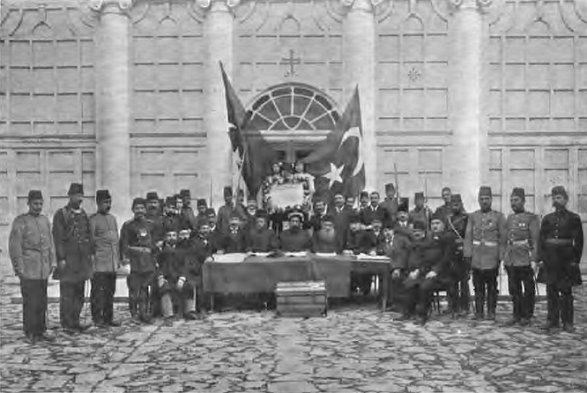
France-Turkey: The night will end by Maxime Gauin*
31 January 2012The Armenian claims have been discussed in the French Parliament since 1975 (rejected in 1975, 1985, 1987 and 1996, adopted from 1998-2001), but, clearly, the discussions and the vote had never come so far.What has happened since December could appropriately be called the culmination of stupidity. One senator, Sophie Joissains of the Union pour un Mouvement Populaire (UMP or Union for a Popular Movement), elected from Bouches-du-Rhône — the county with the most vituperative Armenian community of France — even expressed regret that the Treaty of Sèvres was never implemented. On the other hand, if in the National Assembly chairman of the Franco-Turkish Friendship group, Michel Diefenbacher, was a bit alone in maintaining honor by his good speech delivered against the Boyer bill, a significant number of members of parliament fought the text fiercely in the Senate, accumulating motions of dismissal, cancellation of amendments and speeches to defend their position.
The responsibility falls primarily on Nicolas Sarkozy, who pressured the UMP group to either abstain from voting or vote for the bill. Indeed, the main change in comparison to the vote of May 4, 2011, when the previous Armenian bill was rejected, is the change of votes within the UMP: 19 voted against, but 137 did so on May 4, 2011; 56 abstained, but only 10 did during the preceding vote; 57 voted for, but only nine did the last year. The Socialist group was pressured as well, but the results were much more mixed: On May 4, 2011, 21 voted against the bill, 39 for and 55 abstained; on January 23, 2012, 26 voted against, 56 for and 48 abstained. In addition to the courageous fight of the Socialist chairman of the Law Committee, who presented in vain a motion of dismissal, Chairman of the Foreign Affairs Committee Jean-Louis Carrère, also a Socialist, repeatedly expressed his anger against the bill and voted accordingly. Other examples can be provided.
We have not been closer to a rupture in Turkish-French relations since the Ankara Agreement of 1921. Regardless, paradoxically, the crisis can be resolved by the collapse of Armenian nationalism in France. Indeed, the Boyer bill is totally unconstitutional (a violation of free speech, among other rights) and is backed by a January 2001 law of that recognizes the unsubstantiated “Armenian genocide” claims. Article 34 of the French Constitution precisely defines the scope of the law and there is no legal value for simple statements. The jurisprudence of the Constitutional Council is clear: When two laws are closely connected, and when someone is apprehended for having violated one of them, the council can check both; if an article of law is pure rhetoric, it is simply censored. As a result, if 60 senators (among the 86 who voted against) take the issue to the Constitutional Council, the two bills will be thrown out. If not, the first person to be charged could file a Priority Question of Constitutionality; it would take more time, but the result would be exactly the same. In any case, the Armenian nationalist leaders would have to explain to their activists why they vehemently supported the suicidal second bill. The strident hostility of most editorialists, of many historians, jurists and other intellectuals as well as many ordinary citizens, shows that the throwing out of these bills would be welcomed. For the moment, the Turkish government’s reactions are relatively quiet, chiefly because of this constitutionality problem. That is why we can hope that the Armenian nationalists will not completely achieve their traditional objective: to create crisis between Turkey and other countries.
The Armenian Revolutionary Federation (ARF) joined the Italian Fascists and the Nazi regime in the 1930s not only for ideological reasons, but also with the hope of sparking a war with Ankara. The ARF shamelessly joined the USSR in 1972 to participate in the destabilization of a NATO member. Since 1987, hindering the Turkish candidacy to the EU has been one of the main objectives of Armenian nationalist groups.
On the other hand, it would be totally wrong for the Turkish side to simply wait in the hope that the Constitutional Council finishes off Armenian nationalism in France. Turkey believed Armenian nationalism was dead in 1923, for example, but it was not. More particularly for the current French case, the pressures on the Socialist group are mostly due to the close relations between ARF leader Mourad Papazian and the Socialist candidate for the presidency, François Hollande. There is no miraculous method through which to seize the current situation and thoroughly crush Armenian nationalism in France. However, there are partial, efficient solutions. One of them is to organize, by all legal means, the defeat of a significant number of deputies who voted for the Boyer bill in the National Assembly. Another is to finally translate into French the main scholarly contributions to the Armenian question and other sensitive aspects of Ottoman and Turkish history published during the last 20 years — those of Ferudun Ata, Edward J. Erickson, Yusuf Halaçoğlu, Guenter Lewy, Justin McCarthy and others. More generally, relations with France (the second-largest investor in Turkey) deserve new, additional, permanent structures and, in such a perspective, US-Turkish relations could provide a certain inspiration.
Between 1921 and 1922 the Franco-Turkish alliance was restored, in great part by two ministers of foreign affairs: Raymond Poincaré from the center right and Aristide Briand from the center left. We could have a kind of new Raymond Poincaré with Alain Juppé. A new Aristide Briand is wanted.
*Maxime Gauin is a researcher at the International Strategic Research
Organization (USAK) in Ankara.
-

France-Turkey: What Went Wrong?
Maxime Gauin The Orwellian bill punishing the “denial” of the unsubstantiated “Armenian genocide” claims will be discussed at the end of January in the French Senate. France is alone in such a case: The few other attempts, in Slovakia for example, failed and were not even discussed in the parliament. France has the longest tradition of alliance with Turkey. It was the first major power to understand what Armenian nationalism really is, and as a result, to break its alliance with the Armenian committees after WWI and sign peace with the Kemalists, who even received weapons against the Greek invaders whose crimes were publicly denounced by French diplomacy in 1922, by order of the President of the Ministers Council Raymond Poincaré. So, beyond the sui generis case of Nicolas Sarkozy, what went wrong? Having arrived en massein France as soon as the 1920s, the Armenian nationalists secured, through a long-term effort, the unconditional support of a few dozen MPs. But this is not the main problem: The overwhelming majority of the deputies did not attend the vote of December 22, 2011, chiefly because they did not dare to express their opposition to the bill. Some deputies elected by districts including significant populations of Turkish origin are among them. In contrast, Michel Diefenbacher, president of the Franco-Turkish friendship group, who saved the honor of the National Assembly with his good speech against the Boyer bill, is not elected by a district inhabited by a numerous population of Turkish origin.
The main problem is that the Turkish immigrants in France are, as a whole, the less educated and the less organized in the West. For years, this community was rather neglected and received too little encouragement to organize itself. There are definitely improvements, but they are still ongoing and too recent to prevent the vote in the National Assembly or the principle of a discussion in the Senate. Regarding the Armenian issue, virtually no scholarly book rejecting the “Armenian genocide” label was translated into French and published since 1991. In contrast, Kâmuran Gürün’s Armenian File was published in French in 1984, one year after the original Turkish edition and two years before the English edition; this French version is now out of print, unlike the English one. The resources of the anti-defamation French legislation, more protective than the U.S. one, were very rarely used by the Turkish side and independent historians against the hate propaganda of Armenian and Kurdish nationalists.
Regardless, the U.S. case can provide a certain inspiration. There was an absurd crisis between Ankara and Washington in 1974, when Congress decided, because of the Greek and Armenian lobbies, to forbid the sale of military weapons to Turkey. In large part because of that, the Assembly of Turkish American Associations was eventually created in 1979. The serious problems which took place at the beginning of the 2000s (Armenian resolution in 2000, Iraq war and its aftermath) led to the creation of the Turkish Coalition of America, Turkish Cultural Foundation and Turkish American Legal Defense Fund.
What the shared Franco-Turkish interests need, as does the value of free speech, are a similar and coherent strategy of organization, education and legal defense. That means a quick conclusion of the preliminary work to establish the Coordination Committee of Franco-Turkish Associations; an effort to diffuse the Turkish culture in France by stressing the old, historical ties; permanent structures of big business, politicians and others to fight anti-Turkish propaganda and bills; and a permanent structure of legal defense.
An opportunity to crush the Armenian nationalism in France was missed because the anti-ASALA legal cases from December 1984 to November 1986, remarkably managed, were incomplete; Jean-Marc “Ara” Toranian in particular, spokesman of ASALA from 1976 to 1983, now co-chairman of the Coordination Council of France’s Armenian Associations, was never sued for the glorification of crime and contempt of court. The current opportunity should not be missed: There is an exceptionally widespread exasperation, in the country of Voltaire and Diderot, against the special ethnic interests which advocate a drastic limitation of free speech and are damaging the relations of France with a rising regional power.
*This piece was firstly published by Hurriyet Daily News.

